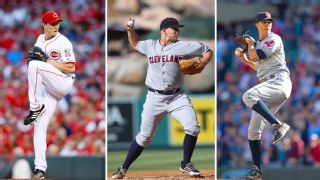|
Homer Bailey's shiny new six-year, $105 million extension is a clear sign that the Reds believe that his 2013 breakout was no fluke. While Bailey's career up to last year had been somewhat inconsistent, that kind of price requires Bailey to keep pitching at the level he did last year. And there are reasons to think that he may very well do that. Perhaps most important in his breakout was a sharp uptick in his strikeout rate, which went from 19.2 percent in 2012 to 23.4 percent last year. In terms of ranking against his peers, he went from 27th in the National League two years ago to eighth last year, as even just a few points of strikeout rate can make a big difference. And strikeout rate is the kind of metric that seems somewhat impervious to fluke seasons. You can either get guys to swing and miss or you can't, and we just don't see too many Brady Anderson-type seasons when it comes to pitcher's strikeout rates. But how much of a strikeout rate spike can we really expect to carry over from one season to the next? Bailey isn't the only pitcher this question is relevant for, after all. The Orioles are hoping that Ubaldo Jimenez's 25 percent strikeout rate in 2013 is far more predictive than the 18 percent strikeout rate he posted in 2012, and the Tigers chose to keep Rick Porcello over Doug Fister partly due to Porcello's jump from a 13.7 percent strikeout rate to 19.3 percent last year. The Indians are trying to figure out whether to sign Justin Masterson to a long-term deal, and a large part of the question will come down to whether they believe in Masterson's 2012 (17.6 percent) or his 2013 (24.3) strikeout rate. So, let's look at other recent spikers, and see how well they did after posting big strikeout rate gains from one season to the next. First, the top five starters in strikeout percent increase from 2010 to 2011:
|


